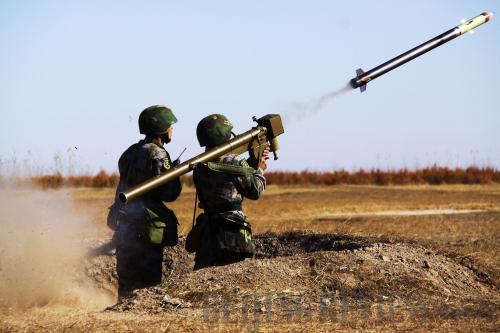|

The Chinese People's Libera-tion Army (PLA) is exploring larger and new types of military drills to identify shortcomings and improve training capabilities as it strives to integrate all its services and civilian support into seamless operations.
Military drills in 2009 featured an increased emphasis on simulating real combat, improving long-distance combat capabilities, simulating warfare in a complicated electromagnetic environment, carrying out joint exercises involving the several armed services and conducting military operations other than war (MOOTW).
 |
|
CLEARING THE SKIES: Shenyang Military Area Command air defense forces conduct their annual strike capacity appraisal LIU FENGAN | Military drills are designed to simulate all aspects of the real conditions of war. The first-ever theater-level joint exercises of the PLA, which were held in Jinan, Shandong Province, in June and July 2009, demonstrated the PLA's explorations of joint operations and command of the various arms of its services. This exercise exhibited an essential requirement for exercises later in the year that sought new ways to operate and train.
|

|
|
TANK KILLER: An anti-tank missile is fired during a military exercise in October LIU FENGAN | The PLA launched its largest-ever tactical military exercise in August 2009 to improve its long-range troop projection ability. The exercise, codenamed "Stride 2009," involved the deployment of four divisions from four of China's seven military area commands (MACs). Nearly 50,000 heavily armored soldiers participated in the two-month exercise.
Unlike previous annual tactical exercises, the four divisions and their air units were deployed by civilian rail and air transport into unfamiliar areas far from their garrison training bases. The division from the northeastern Shenyang MAC was transported to northwestern Lanzhou MAC. Troops from eastern Jinan MAC and southern Guangzhou MAC exchanged positions.
The PLA's air transport maneuverability was tested during "Airborne Maneuver 2009" exercise, where three divisions of airborne corps transported 13,000 troops and 1,500 vehicles over more than 2,000 km in three weeks.
To underscore attempts to make the exercises more like real war, the PLA used more adversarial training and war games. In the "Victory 2009" troop confrontation exercise, the "red" and "blue" sides followed their own ideas to carry out operations while the directing group of the exercise only served as a judge.
In 2008, the PLA adopted the new Outline of Military Training and Evaluation, which requires that confrontation training be an essential part of uplifting training levels as well as the basic training form.
Almost all military drills in 2009 included testing the PLA's combat effectiveness using electronic warfare. During the adversarial trainings and drills of the "Stride 2009" military exercise, competing sides were required to suppress their adversary's electronic devices and countermeasures in a complex electromagnetic environment.
During one of these trainings, when the regular communication system between headquarters and motorized infantry division troops was disrupted by the adversary's electromagnetic assault, soldiers quickly switched to a backup radar communication system and the Chinese Compass satellite communication system, which enabled them to resume communications in less than 10 minutes.
More and more military drills involve joint operations between different services and arms of the PLA to help adapt the traditional command system of China's armed forces, which was dominated by the Army, to a more comprehensive one.
| 